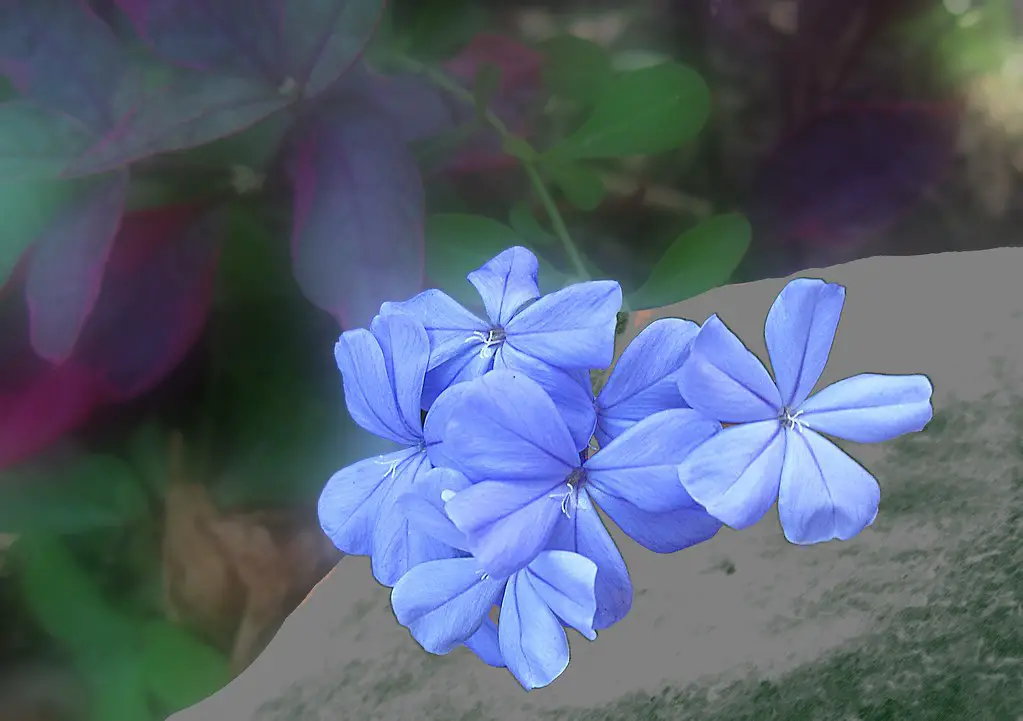Plumbago, a genus of 10-20 species of flowering plants, is best known for its beautiful blue or white flowers. These plants, native to warm temperate to tropical regions of the world, are often grown in gardens for their attractive appearance and ease of care. Plumbago flowers are tubular, but the petals are large and create a showy display that lasts throughout the growing season.
This plant’s common name, Plumbago, is derived from the Latin word for lead (“plumbum”), possibly referring to the blue color of lead. Some also believe it to be a remedy for lead poisoning. Whatever the origin, there’s no doubt that the Plumbago’s unique coloration and graceful growth habit make it a captivating addition to many landscapes.
In the wild, Plumbago can be found growing along streams, in open woodlands, and various other natural habitats. It’s an adaptable plant that is not only beautiful but also attracts butterflies and other pollinators. Its versatility in the garden and ease of maintenance make it a preferred choice among gardeners.
| Aspect | Details |
|---|---|
| Common Names | Plumbago, Leadwort, Cape Leadwort |
| Botanical Name | Plumbago auriculata (for the blue species) |
| Family | Plumbaginaceae |
| Plant Type | Shrub |
| Mature Size | 3-10 feet tall, 3-10 feet wide |
| Sun Exposure | Full sun to partial shade |
| Soil Type | Well-drained, moderately fertile soil |
| Hardiness Zones | 9-11 |
| Native Area | South Africa, parts of Southeast Asia |
Plumbago Care
Plumbago is known for its minimal care requirements, making it a favorite among both novice and experienced gardeners. Its drought tolerance, coupled with its ability to thrive in various soil types, allows it to flourish with relative ease.
Proper placement, watering, and a little attention to its basic needs will ensure that Plumbago provides a continuous display of beautiful blue or white blooms. Whether grown as a border plant, in containers, or as a specimen, its eye-catching flowers are sure to attract attention.
Light Requirement for Plumbago
Plumbago thrives in full sun but can also grow in partial shade. In full sun, the plant produces the most vibrant and abundant blooms. In too much shade, the plant may become leggy and produce fewer flowers.
Soil Requirements for Plumbago
While Plumbago is tolerant of many soil types, it prefers well-drained, moderately fertile soil. Avoid soils that are too heavy or soggy, as they can lead to root rot. A pH range of 5.5 to 7.5 is ideal.
Water Requirements for Plumbago
Plumbago is drought-tolerant once established but prefers regular watering during the growing season. Reduce watering in the winter months and allow the soil to dry slightly between waterings.
Temperature and Humidity
Plumbago prefers warm temperatures and can grow in humid conditions. It thrives in temperatures between 60-90°F (15-32°C) and can tolerate light frosts in hardiness zones 9-11.
Fertilizer
Feed Plumbago with a balanced fertilizer in the spring and again in mid-summer. A slow-release granular fertilizer works well, promoting steady growth and flowering.
Pruning Plumbago
Plumbago benefits from regular pruning to maintain shape and encourage bushier growth. Prune in late winter or early spring before new growth starts. Deadheading spent flowers will also promote continuous blooming.
Propagating Plumbago
Propagate Plumbago through stem cuttings or layering. Take cuttings in early spring, and plant them in a soilless potting mix. Layering involves bending a low-growing branch to the ground and partially burying it until roots form.
How To Grow Plumbago From Seed
Growing Plumbago from seed is less common but can be achieved by sowing seeds indoors 6-8 weeks before the last expected frost. Use a well-draining soil mix, and keep the soil moist until germination.
Common Pests & Plant Diseases
Aphids
Small insects that can be treated with insecticidal soap or neem oil.
Powdery Mildew
A fungal disease that can be controlled with proper airflow and fungicide.
Common Problems With Plumbago
Yellowing Leaves
Usually a sign of overwatering. Adjust watering and ensure proper soil drainage.
Leggy Growth
Often due to insufficient light. Move the plant to a brighter location if possible.
Failure to Bloom
Could be a result of too much shade or insufficient nutrients. Adjust location or feed with a balanced fertilizer.
Pro Tips
- Plumbago can be grown as a ground cover or trained to grow on trellises.
- It is deer-resistant, making it suitable for gardens with deer problems.
- Plant near patios or walkways to enjoy the butterflies and hummingbirds it attracts.
- Mulch around the base to conserve moisture and suppress weeds.
- Consider planting with other plants that complement its vibrant blue color, such as yellow marigolds or white roses.




